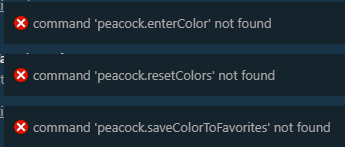Have you ever found yourself switching between multiple instances of VS Code, while trying to find which one you were looking for? I often have multiple instances open for coding, writing (like this article), and pretty much everything I do with text. Being able to quickly identify each instance is super helpful.
I used to switch the colors of a few key aspects of VS Code manually so I could differentiate them. I was using this technique at conferences where I presented and found it helpful for the audience so they could identify my code too. I finally decided to automate this. That's where Peacock came from.
One of the key aspects I wanted before releasing v1 was to have a lot of unit tests in place, and to have it hooked into CI. I decided to use Azure DevOps with their YAML option. I am pretty happy with how it turned out. One cool aspect is I am running the tests under Windows, Linux, and macOS for both Node 8 an 10. I'll write more about how this works on Azure DevOps in future posts.
v1 has arrived!
I just released Peacock v1.1.0 over the weekend!
Since I released and announced the preview of Peacock, a lot of folks seemed to like it and several contributed to the extension in OSS.
What Can it Do?
Great question! You can check out the full documentation here. But here is a quick glimpse of the main features.
- Change the color of titlebar, statusbar, and/or activitybar
- Enter your own color (hex, rgb, hsl, etc)
- be surprised with a random color
- Choose the primary color for angular, vue, or react
- Choose a user-defined color from your Favorites
- Save a color in your Favorites
- Adjust the coloring of affected elements by making them slightly darker or lighter to provide a subtle visual contrast between them
You choose which elements should be colored be checking them in your user settings.
Get Peacock
If you have Peacock and want the update to v1.1.0, VS Code will prompt you soon.
If you are interested in trying out Peacock, you can find it here in the marketplace.
Contribute
Contribute to GitHub repository here
Thanks!








Top comments (37)
Thanks a lot...
When I first saw your post about this extension I thought it was neat but I didn't think I would have much use for it, but after working on a project this weekend and fooling around with different vscode windows, it got me thinking and now I'm on board.
Thanks! No worries, several people have said this too :)
Some folks only use one instance ... while others use several.
Thank you, John.
I can't wait to give it a try.
But I seem to have run into a problem.
Anyone else having the issue by chance? 😅
Running Peacock via
Show all commands: ctrl+shift+pfails to run and showscommand peacock.{all peacock commands} not foundalert message.Version Information
Repro steps
The log given by the failure
I get following error popups for every command
Mention any other details that might be useful
I've also tried this on Ubuntu but the error occurs the same way.
Thanks for reporting this in GitHub too! I found the issue and published a fix. Please try it out and let me know if it works.
Sorry for the inconvenience and thanks for taking the time to help out!
No thank you, John~
v1.2.1 works and looks aaamazing~ 😍
Wow! This is perfect, I can't wait to give it a shot. My last job was at an agency, and I'd use a different Code window for each client project, always getting them jumbled and confused. This would've been a big help.
It's definitely a lifesaver for me :) Thank you @john_papa
You are welcome. thanks for using it
Very cool!
thanks!
this is what i was looking for..Thank You
you are quite welcome
Thanks!
One idea you could try is to create a "favorite" and save it for the different languages, the choose those for the projects.
I think what you are suggesting though is that when Peacock starts up it could try to determine the language if your project and choose a specific color for it. Feel free to add to the issues.
Awesome! This is one of my favorite VS Code Extensions.
Thanks! I appreciate the support
I thought this was a really neat extension when I installed it a couple of weeks ago, but then this week when I started using RemoteFS to connect to my different Linux boxes it became absolutely essential for keeping track of which server I'm connecting to. Thank you for this!
Awesome!
Thanks!